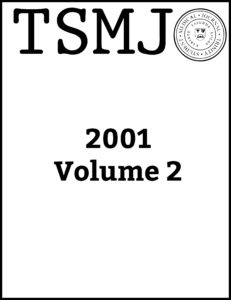Cat Eye Syndrome
Keywords:
MedicineDownloads
References
2 Schachenmann G, Schmid W, Fraccaro M et al. Chromosomes in coloboma and anal atresia. (Letter) Lancet II 1965;290.
3 Gardner RJM, Sutherland GR. Chromosome Abnormalities and Genetic Counselling 2nd edition, London: Oxford University
Press, 1996, p.12.
4 Schinzel A, Schmid W, Fraccaro M et al. The “cat eye syn- drome”: dicentric small marker chromosome probably derived from a no.22(tetrasomy 22pter to q11) associated with a charac- teristic phenotype. Report of 11 patients and delineation of the clinical picture. Human Genetics 1981;57(2):148-158.
5 Frizzley JK, Stephan MJ, Lam AN, et al. Ring Duplication/Deletion Mosaicism: clinical, cytogenetic and molecular characterisation. J Med Genet 1999;36(3):237-241.
6 Cat Eye Syndrome. Available at: Cat eye syndrome: Online medelian inheritance in man (OMIM ref #115470), John Hopkins University http://www.ncbi.nlm.nih.gov/entrez/dispomim.cgi?id =115470 Accessed February 9, 2001.
7 Luleci G, Bagci G, Kivran M et al. A hereditary bisatellite- dicentric supernumery chromosome in a case of cat eye syn- drome. Hereditas 1989;11:7-10.
8 Riazi MA, Brinkman-Mills P, Nguyen T. et al. The human homolog of insect-derived growth factor, CECR1, is a candidate gene for features of cat eye syndrome. Genomics 2000;64(3):277- 285.
9 McTaggart KE, Budarf ML, Driscoll DA et al. Cat eye syn- drome chromosome breakpoint clustering: identification of two intervals also associated with 22q11 deletion syndrome break- points. Cytogenetics & Cell Genetics 1998;81(3-4):222-228.
10 Edelmann L, Pandita RK, Spiteri E et al. A common molecu- lar basis for rearrangement disorders on chromosome 22q11. Human Molecular Genetics 1999;8(7):1157-1167.
11 Lissauer T, Clayden G. Illustrated Textbook of Paediatrics. London: Mosby Publishing;1997, p.53.
Downloads
Published
How to Cite
Issue
Section
License
Authors retain copyright and grant the journal the right of first publication with the work simultaneously licensed under a Creative Commons Attribution (CC-BY) 4.0 License that allows others to share the work with an acknowledgement of the work’s authorship and initial publication in this journal.
Provided they are the owners of the copyright to their work, authors are able to enter into separate, additional contractual arrangements for the non-exclusive distribution of the journal’s published version of the work (e.g., post it to an institutional repository, in a journal or publish it in a book), with an acknowledgement of its initial publication in this journal.



